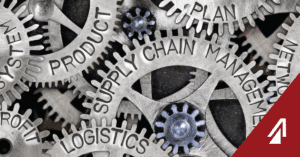2021 finished up strong with significant GDP growth and unemployment reductions. However, COVID-19 concerns were still prevalent, causing a cascade of downstream issues in the remaining logistics sectors. Short staffing, reduced capacity, and rising inflation were also significant factors facing the logistics industry, but 2022 promises to show greater economic recovery and advancement. See more in this month’s state of the industry report.
Coronavirus
Concerns from the Omicron variant in December have been causing flight cancellations around the world. This has significantly reduced air freight capacity. However, a major North American airline, Air Canada, is working to respond to these shortages by opening more cargo capacity in and out of Vancouver – relieving much of the stress in the Pacific Northwest.
Sea freight continues to be affected by staffing shortages and delays at the ports of Los Angeles and Long Beach. Currently, as many as 70 vessels a day are waiting to be unloaded and both ports are overflowing with both full and empty containers. The overflow has become such an issue that port authorities have threatened to issue what has been colloquialized as a “super demurrage fee.” This fee would charge shipping lines $100 per day per container and would increase the fee $100 each day until the container is removed. Fees would start 9 days after arrival at the terminal for local delivery containers and after 3 days for rail containers. It is estimated that approximately 40% of containers that land in the ports of Los Angeles and Long Beach would be affected by this charge. The fee was proposed back in November, but with ongoing chassis and warehouse shortages, it has yet to be implemented.
Also, European ground shipping is delayed due to renewed COVID lockdowns in major centers like Germany, Austria, and Denmark. These lockdowns create labor shortages that continue to disrupt supply chain operations.
GDP
The US economy grew by a rate of 2.30% in Q3. This is slightly higher than the projected 2.10% growth but is less than Q2’s 6.7% spike. Market analysts project Q4 to reach 4% growth and 2.5% growth in 2022.
Employment
The unemployment rate fell to 3.9% in December. This is a .3% drop from November. The highest employment growth sectors include leisure and hospitality, professional and business services,
manufacturing, construction, and transportation and warehousing. While this change is positive, the overall labor force is still struggling. According to the Bureau of Labor Statistics, “The labor force participation rate was unchanged at 61.9 percent in December but remains 1.5 percentage points lower than in February 2020.”
Inflation
December’s inflation rate was the highest since June of 1982. US inflation rose to 7%, compared to 6.8% in November – another record month. The largest inflation rates occurred in the energy (29.3%), gasoline (49.6%), shelter (4.1%), food (6.3%), vehicles (11.8% – new, 37.3% – used), apparel (5.8%), and medical services (2.5%). Soaring inflation rates have been attributed to “pandemic-induced supply constraints, soaring energy costs, labour shortages, increasing demand and a low base effect from 2020,” says market analysis group Trading Economics. “Inflationary pressures are likely to last well into the middle of 2022 and Fed Chair Powell recently pledged to do what’s necessary to contain an inflation surge including increasing interest rates.”
Manufacturing
The IHS Markit US Manufacturing PMI was revised to 57.7 in December 2021. This rate signals a strong expansion in factory activity. However, companies are also recording the softest rise in new orders for a year as well as worsening vendor performance. This deterioration is attributed to material shortages, greater costs, and inflation. Many companies are unable to pass on these costs to customers because of softer market conditions. However, in spite of this, 2022 is expected to increase output percentages due to relief in supply chain disruptions and greater hiring capabilities.
Interest Rates
The Fed announced this month that it would end its pandemic-era bond purchases in March, paving the way for 3 interest rate hikes by the end of 2022. They have also doubled the pace of tapering to $30 billion a month.
Capacity
US ground capacity has tightened since November amidst the holiday season. The December load to truck ratio rose to 6.04:1 and reflects a 35% increase over the same period last year.
Air travel, while still limited by fears of Omicron, is increasing. Southwest Airlines announced that it will resume 50+ routes as well as add 6 more routes in 2022. This will not only affect passenger travel but also allow for more widebody passenger belly capacity.
Sea freight continues to face constricted capacity as more east coast ports face severe congestion. Mediterranean Shipping Company (MSC) is responding with these delays by temporarily removing New York and New Jersey ports from Suez service. Other ports of call will remain unchanged.
Regulations
The US House of Representatives has voted to pass a bipartisan bill that will dramatically affect minimum service standards from ocean freight carriers. The Ocean Shipping Reform Act of 2021, H.R. 4996 passed with a 364-60 majority. The bill was introduced by representatives John Garamendi (D-CA) and Dusty Johnson (R-SD) in late August with the finally vote taking place in December. The objective, according to lawmakers, is to make the Federal Maritime Commission (FMC) “a more effective federal regulator.”
According to Congress.gov, the bill:
- sets forth requirements for operating a shipping exchange involving ocean transportation in the foreign commerce of the United States
- requires ocean common carriers to report to the Federal Maritime Commission (FMC) each calendar quarter on total import and export tonnage and the total loaded and empty 20-foot equivalent units per vessel that makes port in the United States
- requires the FMC to publish and annually update all its findings of false certifications by ocean common carriers or marine terminal operators and all penalties assessed against such carriers or operators
- revises annual reporting requirements for the FMC on foreign laws and practices to include practices by ocean common carriers
- prohibits ocean common carriers and marine terminal operators from retaliating or discriminating against shippers because such shippers have patronized another carrier, or filed a complaint
- directs the FMC to establish rules prohibiting ocean common carriers and marine terminal operators from adopting and applying unjust and unreasonable demurrage and detention fees;
- authorizes the FMC to initiate investigations of an ocean common carrier’s fees or charges and apply enforcement measures, as appropriate
- directs the Department of Transportation to seek to enter into an agreement with the National Academy of Sciences to study the U.S. supply chain industry, including data constraints that impede the flow of maritime cargo and add to supply chain inefficiencies
- provides authority for the FMC to issue an emergency order requiring ocean common carriers or marine terminal operators to share directly with relevant shippers, rail carriers, or motor carriers information relating to cargo throughput and availability.
This is the first legislation of its kind since the Ocean Shipping Reform Act of 1998. The bill’s next step is to be sent to the Senate for considerations.
Rates
According to DAT Trendlines logistics rates grew 2.5% since November. The average national truckload rate per mile ended the year at $2.99 per mile. This is a 21.7% increase over the same month in 2020.
Behaviors
Inflation has been a supreme factor in determining the public’s current behavior. According to Deloitte, a recent survey found that 73% of respondents are concerned about the dramatic rise in prices. This concern is expected to significantly influence spending. However, in spite of the current situation, more than half the respondents are optimistic about their personal finances in 2022.
Unlike inflation, which is causing concern, greater vaccination rates and lower infection rates have eased consumer perceptions of dangers posed by the coronavirus. More consumers are feeling safe and are spending more on leisure, travel, and dining.
Technology
Congested ports are investing heavily in technology to help ease the strain. The Port of Long Beach, for example, has contracted technology firm UNCOMM to help it create free cargo visibility software. According to a recent press release, the system will give shippers the data to “track their cargo through the complete supply chain.” The port has titled the system The Supply Chain Information Highway and will benefit users by integrating systems into a single portal that allow users secure access and analysis to their data. A proof of concept is scheduled to be demonstrated in February of 2022, and once the prototype is complete, Port of Long Beach will share this tool with other ports.
Fuel Impact
December saw a gradual drop in diesel prices. Prices fell approximately 2.3% since November. However, these prices still reflect a 40.9% increase over December 2020.
Driver Concerns
Recently the 2021 American Transportation Research Institute’s (ATRI) annual survey of industry issues was published. Like the previous 4 years, this year’s study found that Driver Shortages is the overall industry’s greatest problem. Not only was it the most selected, but it was selected 4 times as much as any other issue. But, diving further into the study shows a reason why this is becoming a perennial problem.
The study is broken down by industry segment – each with their own personal top 10 industry concerns. 2021 found that drivers’ top concern to be issues with compensation and parking tied for the number 1 spot. Others, like motor carriers do not include either issue in their own top 10. Meaning, that driver and motor carrier goals are not aligned. This can create a major obstacle to hiring and retaining drivers.
While driver pay may or may not be an area where some negotiation is achievable, motor carriers have no excuse for not advocating for the safety and wellbeing of their drivers. Safe parking has long been an issue in American transportation, and it seems that motor carriers are missing opportunities to make meaningful changes in the industry that support their drivers. Some changes could be to advocate for drivers with shippers that cause extended detention to provide a place for those drivers to dwell safely until they can get on the road. Another idea is working with local, state, and federal governments for more infrastructure to support driver safety.
No matter what form it takes, motor carriers need to stand up for their drivers and show their pride, loyalty, and investment in them. These are the meaningful changes that drivers need in order to perform their job, and if motor carriers can not see that, they will struggle to find workers.



